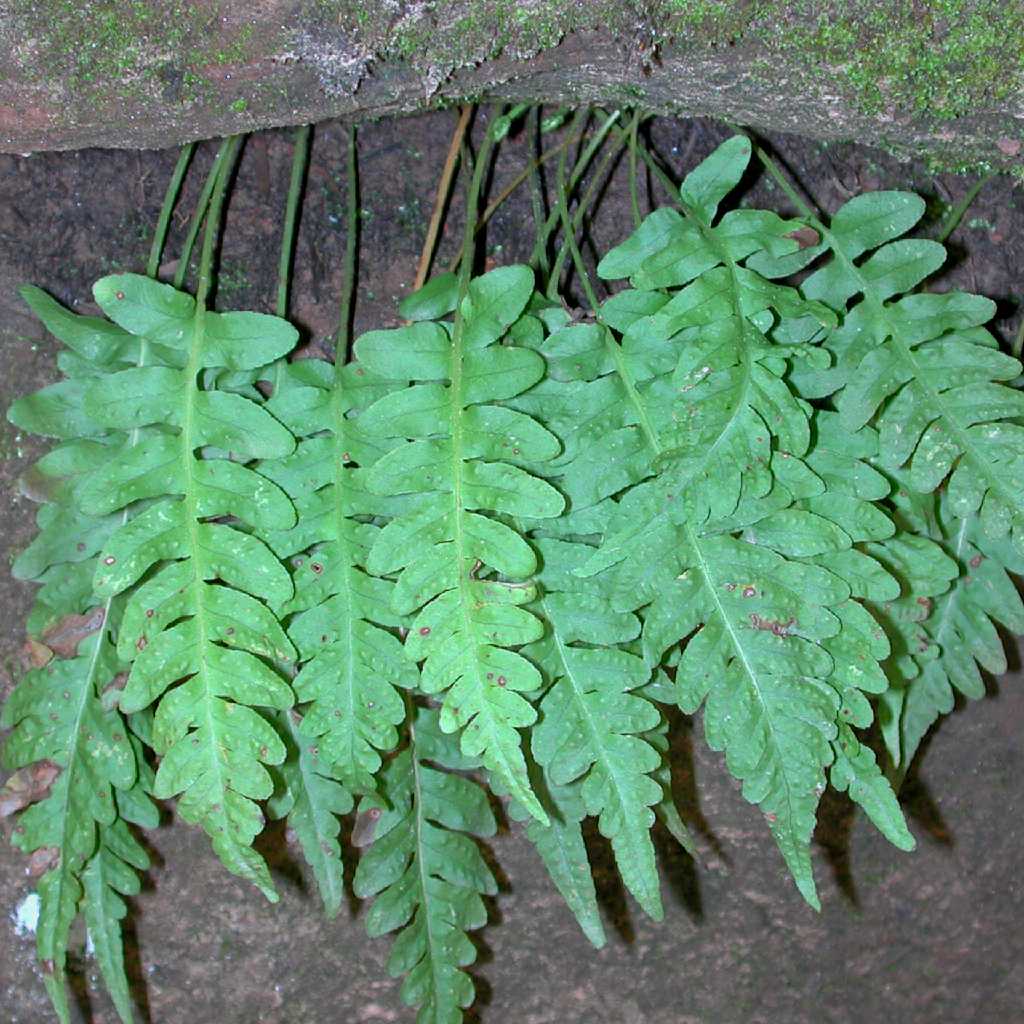Polypodium
|
Family: Polypodiaceae |
Plants on rock, occasionally terrestrial or epiphytic. Stems creeping, usually branched, 3--15 mm diam., sometimes whitish pruinose; scales concolored to bicolored, lanceolate to ovate-acuminate, not clathrate to strongly clathrate, glabrous, margins entire to denticulate. Leaves monomorphic, closely spaced to distant, not conspicuously narrowed at tip, to 90 cm. Petiole articulate to stem, straw-colored, somewhat flattened or grooved to nearly terete, winged distally. Blade broadly ovate to deltate, pinnatifid to 1-pinnate at base, not pectinate, usually with fewer than 25 pairs of pinnae, not glaucous or conspicuously scaly; rachis sparsely scaly to glabrescent abaxially, puberulent to glabrous adaxially; scales ovate-lanceolate to linear, not peltate or clathrate. Segments linear to oblong; margins entire to serrate; apex rounded to attenuate. Venation free to anastomosing, if strongly anastomosing, then never with more than 1 included veinlet in fertile areoles. Sori often confined to distal region of leaf, discrete, circular to oval when immature, borne at tips of single veins, in 1--3 rows on either side of midrib; indument absent or of modified sporangia (sporangiasters), often bearing glandular hairs on bulbous head. Spores monolete, rugose to tuberculate. x = 37. Some species traditionally included in Polypodium are treated here in other genera, for example, Pleopeltis and Pecluma . Except for the tropical species Polypodium triseriale , North American Polypodium is a complex assemblage of interactive species. The North American species have ties to European taxa (e.g., P . vulgare sensu stricto, which probably originated by allopolyploidy between P . glycyrrhiza and P . sibiricum ) but are quite distinct from them. Morphologic comparisons and continuing biochemical and molecular studies indicate that two groups of diploid species occur within the North American P . vulgare complex. One group includes P . glycyrrhiza and P . californicum ; the second, P . amorphum , P . appalachianum , and P . sibiricum . Allopolyploid species have originated following hybridizations within a species group (i.e., P . calirhiza from P . glycyrrhiza × californicum , P . saximontanum from P . amorphum × sibiricum , and P . virginianum from P . appalachianum × sibiricum ) as well as between members of the two groups (i.e., P . hesperium from P . amorphum × glycyrrhiza ). These reticulate relationships are summarized in the reticulogram. We consider P . scouleri to be peripheral to the 'core' diploids even though hybrids have been reported. We have not included the European Polypodium cambricum Linnaeus [ P . australe Fée], reported from San Clemente Island, California (R. M. Lloyd and J. E. Hohn 1969), in the North American flora because, since the single, original collection, efforts to relocate specimens in nature have failed (R. M. Lloyd et al. 1992). Because taste is a characteristic used in the descriptions, the reader is cautioned to taste clean rhizomes from uncontaminated soils.
RHIZOMES: slender to stout, short- to long-creeping, sometimes pruinose or glaucous, densely scaly, the scales concolorous to somewhat bicolorous, not clathrate. LEAVES: usually relatively widely spaced, evergreen or deciduous (drought-deciduous in Arizona species), not hygroscopic. PETIOLES: mostly shorter than the blade. BLADES: slightly thickened, the lobes linear-oblong to linear -triangular, the margins entire or minutely to shallowly crenate or serrate, glabrous or with sparse minute glandular and/or nonglandular trichomes adaxially, with sparse minute glandular trichomes and inconspicuous basally attached lanceolate scales along the midrib and proximal portions of the costae abaxially. VENATION: free or with rare simple areoles, usually easily observed, at least in young leaves. SORI: surficial, naked during development. PARAPHYSES: absent in ours. SPORANGIA: with the capsule nonglandular or rarely glandular. NOTES: Ca. 100 spp., nearly worldwide. (Greek for “many” and “little feet”). Reeves (1981) reported P. glycyrrhiza D. C. Eaton from a steep canyon in the Sierra Ancha (Gila County), but this population has since been described as P. ×aztecum Windham & Yatsk. (2005; Fig. 3), a novel sterile hybrid between P. hesperium and an as-yet unidentified second parent. This tetraploid (2n = 148) hybrid differs markedly from P. hesperium in a number of features, including the following: RHIZOMES 4-9 mm in diameter, not or very slightly pruinose, the scales ovate with a deeply cordate base. LEAVES (7-)20-45 cm long, (3-)6-12 cm wide. BLADES with 8-34 lateral lobes, the midrib and lateral veins with scattered nonglandular trichomes adaxially. SPORANGIA frequently abortive, the capsules with conspicuous 2-celled glands. Polypodium calirhiza Whitmore & A.R. Sm. Of California and Oregon (disjunct in central Mexico) has been suggested as a possible second parent, but presently this species is not known to grow anywhere in Arizona. REFERENCES: Yatskievych, G. and M.D. Windham. Vascular Plants of Arizona: Polypodiaceae. CANOTIA 5 (1): 34-38, 2009. Lvs scattered along the branched, widely creeping rhizome, firm, evergreen, deeply lobed to once pinnate with sessile, broad-based pinnae, the veins free or areolate only along the costae; petiole with 3 vascular bundles below, these uniting distally; sori rotund or elliptic, borne subterminally on the vein-forks. 150+, cosmop. Gleason, Henry A. & Cronquist, Arthur J. 1991. Manual of vascular plants of northeastern United States and adjacent Canada. lxxv + 910 pp. ©The New York Botanical Garden. All rights reserved. Used by permission. |

